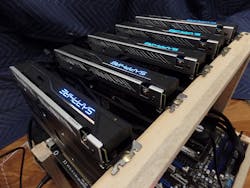Cryptocurrency’s Estimated Draw on World Resources Could Power Bangladesh
When it comes to mining cryptocurrency and how much power is consumed during mining operations globally, nobody knows for sure. However, based on varied utility costs alone, it’s estimated at 53.99 TWh, or enough energy to power the country of Bangladesh annually, according to the Digiconomist Bitcoin Energy Consumption Index—a website dedicated to providing in-depth analysis regarding cryptocurrencies.
Cryptocurrencies are digital assets (currencies) designed for use as a medium of exchange in the same fashion as traditional assets or money. However, they use cryptography to secure transactions as well as control the creation of additional units and the verification of transfer assets. Most, such as Bitcoin and other altcoins, are decentralized, with control mitigated through blockchains. Blockchains are continuously growing lists of records that form blocks (i.e., ledger) containing a cryptographic hash (mathematical algorithm), which makes it tough to alter the data and therefore makes the digital currency secure.
GPU cryptocurrency mining rig. (Image credit: Nathan11466 via Flickr)
Acquiring these cryptocurrencies requires that they need to be “mined,” which is done by utilizing computer processing power through either the CPU, GPU, or both to cryptographically secure the virtual currency. Simultaneously, transactions are approved and new cryptocurrencies are created in the process that can be used as payments to those doing the mining.
To gain digital currency at a higher rate, miners will often string several or more high-end GPUs, which produce a more significant draw on the electrical grid. So much so, that some cities, such as Plattsburgh, N.Y., are banning mining operations in city limits. Not because of single users, but because of extensive mining operations (or a community of miners) could potentially cause a massive drain on the local grid.
So How Much Power is Consumed?
The breakdown of power consumption for mining operations is astounding if Digiconomist is accurate. The amount of electricity consumed per transaction in the U.S. amounts to 788 kWh—just for one coin—which is enough energy to power roughly 27 homes. Global mining operations account for 148,500,609 kWh, or enough electrical energy to power over 5 million U.S. homes. Naturally, the issue of sustainability comes into question, as mining is easily accessible and can create a constant stream of revenue for those willing to run power-intensive rigs to gain it.
The online sustainability website Grist purports that if current mining trends continue to climb, the entire cryptocurrency network will use the same amount of power the world consumes annually by 2020. Obviously, the world can’t double its energy production within that timeframe, nor has it the resources to do so without a rapid increase in resource production and processing.
Bitmain AntMiner S9 ASIC mining rig. (Image credit: Bitmain)
That’s not to say that cryptocurrency mining will continue to rise and consume enormous amounts of power. Computer hardware, especially in the GPU sector, has seen the development of more cards with higher energy efficiency, meaning they can process data using less power. Some companies, including Samsung, Obelisk, and Halong, have also developed new mining hardware known as ASIC miners (aka application-specific integrated circuit). They’re designed exclusively for mining and can outperform traditional equipment while maintaining a high-power-efficiency/data-processing rate.
The Cost Quotient
The question then arises as to whether the power consumption used for mining is justifiable. At a cost-to-revenue standpoint, mining generates $8.4 billion globally at a fluctuating annual rate while consuming $2.7 billion in power from the grid.
Bitcoin, the most popular cryptocurrency, is currently valued at $9,354 U.S. and to earn that coin, users need to mine one block in total. This means that users outfitted with a current high-end GPU would be able to garner one block every 98 years, according to Quora and other online forums. Therefore, it’s impossible to do so unless users either “pool” their resources or work in tandem with other miners, combining their hardware and then splitting the coin value or using an ASIC setup, which can cost more than thousands of dollars.
Power grid. (Image credit: Pexels)
As far as power costs in the U.S. are concerned, MarketWatch released an infographic this past December showing how much it costs to mine a Bitcoin in every state. Louisiana comes in as the least expensive, using just $3,244 worth of power, while Hawaii tops the list at $9,483, nearly three times as high.
With that in mind, cryptocurrencies have practically become a business-only endeavor, considering the costs it takes just to produce one coin. Those with inadequate hardware have turned toward just investing or outright buying through any number of online exchanges, such as Coinbase.
In the end, the issue of whether or not it’s worth it is up to the miner or user. Mining takes a lot of effort and time. While there are ways to make it beneficial by utilizing advanced hardware, pooling, or investment, the possibility exists that cryptocurrency values will drop—that’s been the current trend; even Bitcoin has fluctuated with losses of $800 to $1,000 in a single day.
Like any other investments, cryptocurrency has the potential to soar to new heights or bottom-out in both the short-term and long run. Whether or not it’s sustainable all depends on technology trends, which favor efficiency without a reduction in processing power.





